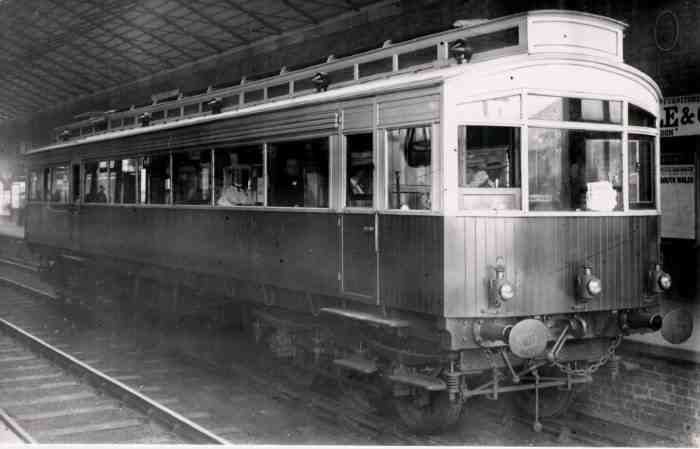Manufacturer North Eastern Railway Number built 2 Fleet numbers 3170 and 3171 | Constructed 1903 Number preserved 1 Capacity 52 seats | |
 | ||
1903 Petrol Electric Autocar. In 1903 the North Eastern Railway built two experimental railcars at their carriage works in York. These were powered by petrol engines which generated electricity for two traction motors which were mounted on the bogie underneath. This means of powering a railway vehicle was pioneering and would eventually be developed into the diesel-electric technology that powered and powers many locomotives worldwide. The railcars were numbered 3170 and 3171 and were 53.5 feet long and weighed around 35 tons. The engine was mounted in an engine compartment 13.25 feet long. The rest of the vehicles' length was taken up by a vestibule, driving compartment and a 52-seat passenger compartment.
Contents
Powertrain
Various petrol engines were used, an 85 hp Napier engine was the first to be installed, but these were found unsatisfactory, so were replaced in 1904 by Wolseley engines. These flat-four engines produced 92 bhp at their normal rated speed of 400rpm, and well over 100 bhp when run at 480rpm. The cylinders were 8.5 inch diameter with 10 inch stroke. The engine had a 3-foot diameter flywheel, and was coupled directly to a Westinghouse multi-polar dynamo. A small dynamo driven by belt from the flywheel provided charge for the accumulators which enabled electric starting of the engine, lighting for the carriage, and the exciting current for the field coils in the main dynamo, controlled by rheostats at either end of the railcar. The engine speed could likewise be controlled via a throttle from either end of the railcar. The output from the main dynamo was sent to two electric motors, both mounted on the bogie underneath the engine room.
In 1923 No. 3170 was re-engined with a more powerful 225HP engine, allowing it to haul an unpowered coach as an early version of the multiple units used today. Maximum speed was only 36 mph but acceleration and braking to and from this was reported to be brisk, taking around 30 seconds. In 1908 a pair of seats were removed to enlarge the vestibules, reducing the seating accommodation to 48. In appearance the railcars were similar to single decker trams. The NER called them autocars as they could be driven from either end, as with modern passenger trains.
Service
The railcars worked in Yorkshire throughout their working life, on lines round Scarborough, Harrogate and Selby. No. 3171 was withdrawn on 31 May 1930 and no. 3170 on 4 April 1931.
Preservation
The body of no. 3170 was used as a holiday home near Kirbymoorside in North Yorkshire for 70 years and was bought by a railway enthusiast in 2003. A trust was formed to restore the vehicle and a trailer coach to form an Edwardian multiple unit that will be twice as old as most of the (ex-BR) DMUs on other heritage railways.
There will be several changes to the autocar to reflect changes in railway technology and regulation. The powerunit is based around a new diesel engine from Cummins and the chassis is a strengthened conversion of one from a GNR milk and brake van. The work done to the chassis has been responsible for substantial delay and expense but is a vital part of the project.
To achieve its aim of restoring the autocar back to working order and restore the trailer coach to go with it, the NER 1903 Electric Autocar Trust has been awarded several grants. The largest grant was awarded in March 2011 from the Heritage Lottery Fund for a total of £465,800. PRISM (the fund for the PReservation of Industrial and Scientific Material) also awarded the project £20,000 for the restoration of the bodywork of the two vehicles, and the Ken Hoole Trust awarded the project £5000 which has gone towards the restoration of the woodwork. In December 2014, the Transport Trust granted the Trust a loan facility of up to £46,000 to cover any shortfall in the Trust finances, caused by the extra expense on the chassis.
Restoration work has been going on for over four years. The Trust's web-site has details of the latest developments and news is also posted on the LNER Encyclopedia's Forum page and on RMWeb.
In addition to the autocar, the Trust is restoring a NER 'autocoach', which was kindly donated to the Trust by the coach group at the North Yorkshire Moors Railway. This was stabled at Levisham for many years but is now (February 2016) substantially restored and is expected to enter service sometime in 2016 on the Embsay and Bolton Abbey Steam Railway.
The Trust is always looking for volunteers or members to support the project either by working on restoration, on 'back room' tasks or via a financial donation.
Modelling the autocar
Following the renewed interest in the petrol electric autocars after the founding of the Trust, two manufacturers make model kits of the autocars. In 2 mm and 4 mm (OO Gauge) scales, Worsley Works makes an etched brass kit of the body. 3 mm scale etches have also been produced to order. In 7 mm (O Gauge), NER Days makes a kit in nickel-silver. A series of articles was written about the construction of one of these by a Trust member in the quarterly newsletter (issues 7 - 16) back copies of which can be downloaded from the membership page.
